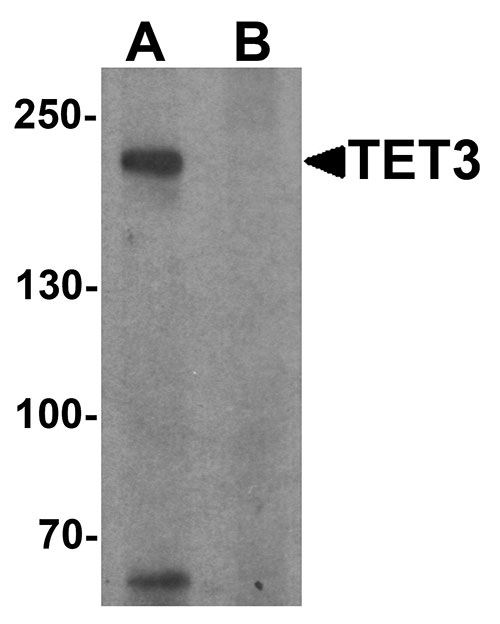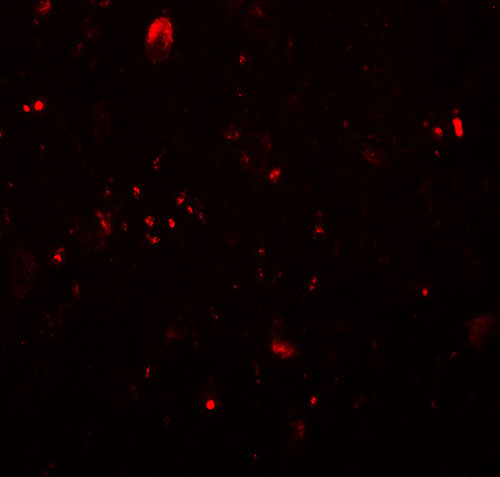TET3 Antibody
- 产品详情
- 实验流程
- 背景知识
Application
| WB, IF, E |
|---|---|
| Primary Accession | O43151 |
| Other Accession | NP_001274420, 149944516 |
| Reactivity | Human, Mouse, Rat |
| Host | Rabbit |
| Clonality | Polyclonal |
| Isotype | IgG |
| Calculated MW | 193705 Da |
| Concentration (mg/ml) | 1 mg/mL |
| Conjugate | Unconjugated |
| Application Notes | TET3 antibody can be used for detection of TET3 by Western blot at 1 µg/mL. For immunofluorescence start at 20 µg/mL. |
| Gene ID | 200424 |
|---|---|
| Other Names | Methylcytosine dioxygenase TET3, 1.14.11.n2, TET3, KIAA0401 |
| Target/Specificity | TET3; At least three isoforms of TET3 are known to exist. TET3 antibody is predicted to not cross react with other TET proteins. |
| Reconstitution & Storage | TET3 antibody can be stored at 4℃ for three months and -20℃, stable for up to one year. As with all antibodies care should be taken to avoid repeated freeze thaw cycles. Antibodies should not be exposed to prolonged high temperatures. |
| Precautions | TET3 Antibody is for research use only and not for use in diagnostic or therapeutic procedures. |
| Name | TET3 (HGNC:28313) |
|---|---|
| Function | Dioxygenase that catalyzes the conversion of the modified genomic base 5-methylcytosine (5mC) into 5-hydroxymethylcytosine (5hmC) and plays a key role in epigenetic chromatin reprogramming in the zygote following fertilization (PubMed:31928709). Also mediates subsequent conversion of 5hmC into 5-formylcytosine (5fC), and conversion of 5fC to 5-carboxylcytosine (5caC). Conversion of 5mC into 5hmC, 5fC and 5caC probably constitutes the first step in cytosine demethylation (By similarity). Selectively binds to the promoter region of target genes and contributes to regulate the expression of numerous developmental genes (PubMed:23217707). In zygotes, DNA demethylation occurs selectively in the paternal pronucleus before the first cell division, while the adjacent maternal pronucleus and certain paternally-imprinted loci are protected from this process. Participates in DNA demethylation in the paternal pronucleus by mediating conversion of 5mC into 5hmC, 5fC and 5caC. Does not mediate DNA demethylation of maternal pronucleus because of the presence of DPPA3/PGC7 on maternal chromatin that prevents TET3-binding to chromatin (By similarity). In addition to its role in DNA demethylation, also involved in the recruitment of the O-GlcNAc transferase OGT to CpG-rich transcription start sites of active genes, thereby promoting histone H2B GlcNAcylation by OGT (PubMed:23353889). Binds preferentially to DNA containing cytidine-phosphate-guanosine (CpG) dinucleotides over CpH (H=A, T, and C), hemimethylated-CpG and hemimethylated-hydroxymethyl- CpG (PubMed:29276034). |
| Cellular Location | Nucleus {ECO:0000250|UniProtKB:Q8BG87}. Cytoplasm {ECO:0000250|UniProtKB:Q8BG87}. Chromosome {ECO:0000250|UniProtKB:Q8BG87}. Note=At the zygotic stage, localizes in the male pronucleus, while it localizes to the cytoplasm at other preimplantation stages. Binds to the promoter of target genes, close to the transcription start site. {ECO:0000250|UniProtKB:Q8BG87} |
| Tissue Location | Expressed in colon, muscle, adrenal gland and peripheral blood lymphocytes. |
For Research Use Only. Not For Use In Diagnostic Procedures.
Provided below are standard protocols that you may find useful for product applications.
BACKGROUND
TET3 Antibody: TET3, a member of the ten-eleven-translocation (TET) family of genes, is a methylcytosine dioxygenase that catalyzes the conversion of methylcytosine to 5-hydroxymethylcytosine and is most abundantly expressed in hematopoietic cells. Unlike the related TET2 protein, mutations in TET3 have not been observed in any myeloid malignancies. TET3 has been shown to be involved in the demethylation of zygotic DNA before the first mitosis and has been suggested to be involved in the epigenetic reprogramming of the zygotic paternal DNA following natural fertilization and may also contribute to somatic cell nuclear reprogramming during animal cloning.
REFERENCES
Langemeijer SM, Kuiper RP, Berends M, et al. Acquired mutations in TET2 are common in myelodysplastic syndromes. Nat. Genet. 2009; 41:838-42.
Schaub FX, Looser R, Li S, et al. Clonal analysis of TET2 and JAK2 mutations suggests that TET2 can be a late event in the progression of myeloproliferative neoplasms. Blood 2011; 115:2003-7.
Langemeijer SMC, Aslanyan MG, and Jansen JH. TET proteins in malignant hematopoiesis. Cell Cycle 2009; 4044-8.
Gu TP, Guo F, Yang H, et al. The role of Tet3 DNA dioxygenase in epigenetic reprogramming by oocytes. Nature 2011; 477:606-10.
终于等到您。ABCEPTA(百远生物)抗体产品。
点击下方“我要评价 ”按钮提交您的反馈信息,您的反馈和评价是我们最宝贵的财富之一,
我们将在1-3个工作日内处理您的反馈信息。
如有疑问,联系:0512-88856768 tech-china@abcepta.com.























 癌症的基本特征包括细胞增殖、血管生成、迁移、凋亡逃避机制和细胞永生等。找到癌症发生过程中这些通路的关键标记物和对应的抗体用于检测至关重要。
癌症的基本特征包括细胞增殖、血管生成、迁移、凋亡逃避机制和细胞永生等。找到癌症发生过程中这些通路的关键标记物和对应的抗体用于检测至关重要。 为您推荐一个泛素化位点预测神器——泛素化分析工具,可以为您的蛋白的泛素化位点作出预测和评分。
为您推荐一个泛素化位点预测神器——泛素化分析工具,可以为您的蛋白的泛素化位点作出预测和评分。 细胞自噬受体图形绘图工具为你的蛋白的细胞受体结合位点作出预测和评分,识别结合到自噬通路中的蛋白是非常重要的,便于让我们理解自噬在正常生理、病理过程中的作用,如发育、细胞分化、神经退化性疾病、压力条件下、感染和癌症。
细胞自噬受体图形绘图工具为你的蛋白的细胞受体结合位点作出预测和评分,识别结合到自噬通路中的蛋白是非常重要的,便于让我们理解自噬在正常生理、病理过程中的作用,如发育、细胞分化、神经退化性疾病、压力条件下、感染和癌症。







